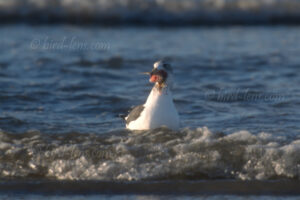 The bright sunrise lets the sky shine in a bright orange and bathes the beach in a golden light. The sunrise bathes the water in an almost magical light. A seagull sits on the sand, looking out to the wide, grey sea, apparently watching the spectacle of the disappearing clouds at the horizon. It’s a massive gull, it’s the native Olrog’s Gull (Larus atlanticus).
The bright sunrise lets the sky shine in a bright orange and bathes the beach in a golden light. The sunrise bathes the water in an almost magical light. A seagull sits on the sand, looking out to the wide, grey sea, apparently watching the spectacle of the disappearing clouds at the horizon. It’s a massive gull, it’s the native Olrog’s Gull (Larus atlanticus).
The sun slowly rises above the horizon and paints the water a shimmering, glittering orange. As the sun rises higher, the gull begins to call. First it’s a clear short “yap” or “yeow”. The seagull then utters a long call, consisting of an accelerating series of clear tones such as “yaaaah yaaaah yah yah yah yah.” The Olrog’s Gull then just sits back and enjoys the warm light of the sun. Maybe she senses it’s going to be a day full of beauty and energy.
The seagull then takes off from the sandy beach and flies on, its voice rising higher and higher into the bright blue sky. Their calls are reminiscent of the immensity of the sea.
Another Olrog’s Gull, standing at the hem in a transitional plumage, is also worth a really good morning photo. On the Internet you can find even more Olrog’s Gulls – also juveniles and in flight – from the Punta Rasa headland here on the Río de la Plata, the confluence of the Paraná and Uruguay rivers, sometimes referred to as a river, into the Atlantic. Punta Rasa in southern Buenos Aires seems to be a very good place to spot this gull.
The Olrog’s Gull is an endangered species endemic to the Atlantic coast of Argentina. It has a limited breeding range, a small overall population and a fairly specialized diet, eating mainly crayfish during the breeding season. Adult birds that do not fly and second-year birds can be confused with the Kelp Gull (Larus dominicanus). However, the Kelp Gull is slightly larger, has an all-white tail, no subterminal band on the beak, and white-tipped wings. Second year Kelp Gulls have a black tail band. The two species overlap in their breeding and wintering ranges, although the Kelp Gull is much more widespread. The Kelp Gull breeds near all known Olrog’s Gull colonies; they also share the non-breeding areas. So there are plenty of opportunities for confusion.
Bird-lens is primarily a website designed to meet the growing demand for high-quality photographs of the birds of the Western Palearctic. In order to satisfy the demand for top-quality photographs of rare bird species, Bird-Lens.com has also made targeted trips to distant places such as Asia, Africa and the Americas. All this in order to be able to take excellent photos of birds. The yield of pictures not only of rare Western Palearctic birds is very good. The beautiful action image of the blog is only a first impression, what you can find in behind the tab “Picture Shop” very soon. Just leave a message if bird-lens.com can serve with a picture.